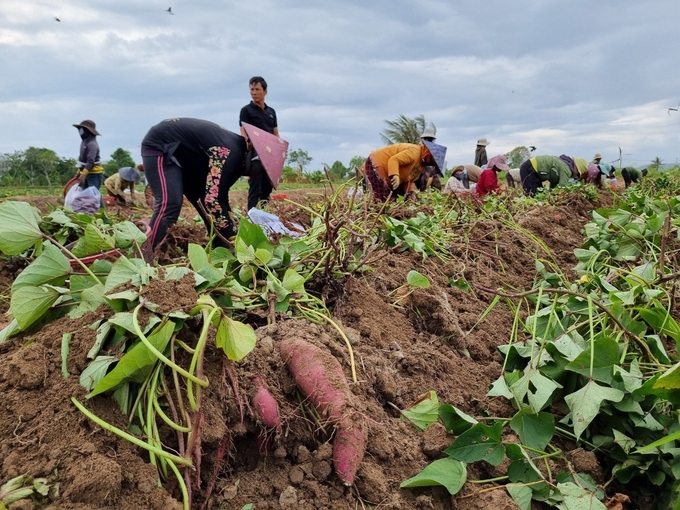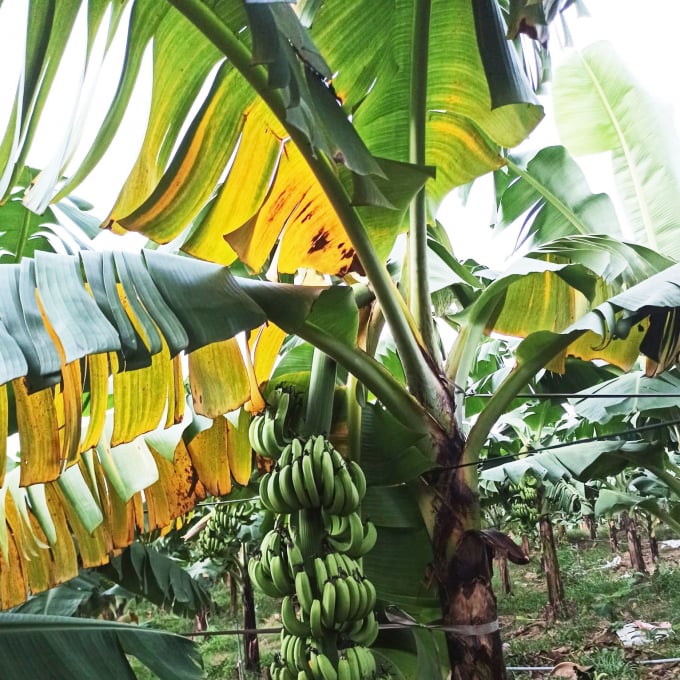October 29, 2025 | 01:15 GMT +7
October 29, 2025 | 01:15 GMT +7
Hotline: 0913.378.918
October 29, 2025 | 01:15 GMT +7
Hotline: 0913.378.918
Professor Dr. Nguyen Hong Son, Director of the Vietnam Academy of Agricultural Sciences (MARD) mentioned the restructuring of crops, the formation of specialized production areas, the increase in the cultivation of perennial crops, intensification, the use of chemical fertilizers, and the reduced use of organic fertilizers, along with limited pest management capacity among farmers, a lack of tools, and effective and feasible farming processes. These factors all contribute to the risk of outbreaks and the spread of soil pests across various crops and ecosystems nationwide, with increasing severity.

In recent years, soil pests have had an increasingly serious impact on many crops, including sweet potatoes. Photo: VAN.
Soil pests are especially damaging fruit trees and perennial industrial crops, causing significant losses, such as quick and slow death disease in pepper plants, seedling death during coffee replanting, root rot in durians, leaf drop in citrus, root rot in dragon fruits, wilting in bananas, and bacterial wilt in solanaceous and cucurbit crops.
Soil pests are difficult to control, and prevention is often ineffective because they are not detected in time or properly addressed. Additionally, at any given time, one or multiple pathogens may appear on a single crop, causing a variety of symptoms, making it challenging to implement effective control measures and increasing costs.
Key diseases affecting major crops include leaf blight and seedling death (caused by Pythium, Phytophthora, Rhizoctonia, Sclerotium rolfsii, and Fusarium spp.) on vegetables, flowers, field crops, fruit trees, and ornamental plants, such as those in the mustard, cucurbit, solanaceous, legume, and aster families.
Root rot (caused by Pythium, Phytophthora, Rhizoctonia, Cylindrocladium, Phellinus spp., Rosellinia, Ganoderma, Armillaria, Pratylenchus) affects woody plants, vegetables, fruit trees, and ornamental plants. Stem rot, crown rot, and collar rot (caused by Phytophthora, Sclerotium, Rhizoctonia, Sclerotinia, Fusarium, occasionally Aspergillus niger, Erwinia) affect vegetables, ornamental plants, and mushrooms.
Bacterial wilt and yellowing (caused by Ralstonia solanacearum, Fusarium oxysporum) affect vegetables, flowers, field crops, fruit trees, and ornamental plants. Yellowing (caused by Fusarium, Nematodes) affects vegetables and flowers. Root swelling (caused by Nematodes, Plasmodiophora) affects vegetables and plants in the mustard, cucurbit, and solanaceous families.

Panama disease (caused by Fusarium spp. in the soil) has greatly affected banana production in our country. Photo: VAN.
Although there has been extensive research on disease-causing agents, studies on effective control processes are still limited or follow only the principles of integrated pest management (IPM). Effective and feasible control processes and tools are lacking. Sustainable biological control measures have not been widely applied, and their effectiveness remains low.
Therefore, applying integrated disease management (IDM) is considered a comprehensive and sustainable approach used in agriculture to control plant diseases.
IDM emphasizes prevention, early detection, and the use of multiple tools to maintain healthy plant populations and achieve optimal yields. Key management measures include plant quarantine, using disease-resistant varieties and rootstocks, farming practices (solarization, soil fumigation, raised planting, crop rotation), good drainage, synthetic pesticides, fumigants, seed treatments, soil pH improvement (increasing the use of organic fertilizers as buffers, using soil amendments like lime and biochar, and appropriate phosphorus fertilizers), and promoting biological control using preparations such as Trichoderma spp. and Streptomyces spp.
Translated by Kieu Chi

(VAN) The Integrated Plant Health Management (IPHM) helps farmers in Quang Ngai increase rice production efficiently and sustainably.

(VAN) Developing low-emission cultivation technology packages, MRV system, strengthening multi-stakeholder cooperation are to realize the goal of low-emission crop production.
/2025/10/23/5928-2-194850_964.jpg)
(VAN) The 'Regenerative cocoa production to support livelihood development in Vietnam' (ReCoPro) project marks an important step toward sustainable cocoa production.

(VAN) Reducing antibiotic dependence in livestock production helps protect public health, enhance food safety, and promote sustainable agricultural development.

(VAN) Experts describe Viet Nam as a 'policy laboratory' within ASEAN, where new agroecological, green finance, and risk-management initiatives are being piloted before wider regional adoption.

(VAN) Limiting rice straw burning and reusing agricultural by-products as materials or fertilizers not only improves soil health but also helps clean the air.

(VAN) ASSET delivers long-term vision and strategy, innovative models, learning networks, policy impact, and measurable environmental benefits.